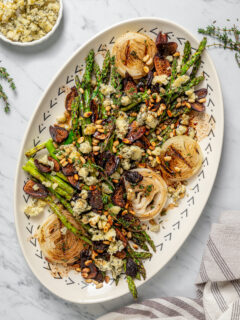I love my Dill plants more for their blooms than the use of the herb in my kitchen. In the middle of summer heat when most flowering perennials are not looking their best, this tall beauty is showing off its goods.
I started mine from seed years ago, because I was told butterflies love them. Never seen a single butterfly on any of my dill blooms. 🙂 What the person probably meant when they told me butterflies love them was that their larvae love to eat them! Every year my Dill hosts a few parsleyworms. Thankfully the first year I noticed them on my dill the larvae were at the end of their life span, and I knew really what these little magical worms were going to look like when they grew up!
I know what your thinking, worm, gross, yuck! We would want to get rid of it right? WRONG! Right now they don’t look like much, and your first thought would be to remove them. But here is the thing…. DON’T! Why? Because as the parsleyworm grows it will turn into a big 2 inch caterpillar that is a spectacular green with bright yellow-dotted black band circling each body segment. Beware, it gives off an odor and projects orange horns when it is upset.
The parsleyworm is the larvae of the black swallowtail butterfly, another beautiful creature. They are black with yellow spots on the edges of their wings, a taillike projection on the hind wings, and a 3 inch wingspan. They are found all over the United States.
However, pay attention to these little catepillars, because parsleyworm will eat the foliage and stems of plants in the parsley family including carrots, celery, dill, and parsnips. Chunks of leaves taken from along their edges are typical signs of parsleyworm attack. Often only stems remain. In a very short period of time, parsleyworm can defoliate a small plant. So, you must decide if you are willing to loose a few plants to see this beautiful butterfly.
Now back to the beautiful Dill plant.
A multi- purpose herb grown for its seeds and foliage. Dill originates from Eastern Europe and is much hardier than most people think.
Fresh, frozen or dried, the ferny foliage and seeds are a tasty flavouring for fish, lamb, new potatoes and peas. Remember to add dill at the end of cooking, because cooking will destroy most of its flavour. It tastes very much like aniseed, so be sparing when adding it to food or it will overwhelm other flavours.
Dill is tolerant of most conditions and easy to germinate, so it causes few problems for novice gardeners. The only problem I have ever had, is how readily it reseeds itself. I have to remove several starter plants in the spring.
The best way how to grow dill is directly from seeds rather than from a transplant. Planting dill seed is easy. Dill planting is simply done by scattering the seeds in the desired location after the last frost. Then lightly cover the seeds with soil. Water the area thoroughly. Dill weed plants grow best in full sun. Other than this, dill will grow happily to its 3 to 5 feet height in both poor and rich soil or in damp or dry conditions.
Start picking the fresh leaves just as soon as they are large enough to use. Pick early in the morning or in the late evening, clipping them close to the stem. If you prefer to harvest dill seed, allow the flowers to form, bloom, then go to seed. Cut the seedheads when the majority of seeds have formed–about 2 to 3 weeks after the blossoming starts–even though some tiny florest may still be blooming. Hang the seedheads upside down by their stems in a paper bag. The seeds will fall into the bag when they mature and dry out.
The health benefits of dill include good digestion, relief from insomnia, hiccups, diarrhea, dysentery, menstrual disorders, respiratory disorders, cancer, etc. It is also good for oral care.
Quick Dill Recipe:
Dill Sauce : Great for veggies a topping for fish or gyros.
Combine 1 cup sour cream, 1 lime juice, 1 clove of minced garlic, 2 tablespoons of olive oil and salt and pepper, mix well. Stir in 1 tablespoon chopped fresh dill leaves















Just started reading your blog! Lets hope you you get some bees in your lovely bee garden.
Thanks for following. Yes, plenty of bees buzzing in the garden. Right now they are mostly feasting on the clover.
great post (and the sauce recipe is heading right up to my kitchen counter)!
Thanks lady!